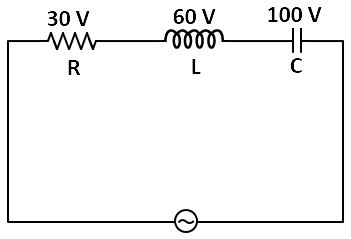A \(100~\Omega\) resistor is connected to a \(220~\text{V}\), \(50~\text{Hz}\) \(\text{AC}\) supply. The net power consumed over a full cycle is:
1.
\(484~\text{W}\)
2.
\(848~\text{W}\)
3.
\(400~\text{W}\)
4.
\(786~\text{W}\)
1. \(1.0~\text{A}\)
2. \(15~\text{A}\)
3. \(15.92~\text{A}\)
4. \(14.29~\text{A}\)
1. \(35\)
2. \(20\)
3. \(15\)
4. \(25\)
The variation of EMF with time for four types of generators is shown in the figures. Which amongst them can be called AC voltage?
 |
 |
| (a) | (b) |
 |
 |
| (c) | (d) |
| 1. | (a) and (d) |
| 2. | (a), (b), (c), and (d) |
| 3. | (a) and (b) |
| 4. | only (a) |
The peak value of an alternating emf \(E = E_{0}\sin\omega t\) is \(10\) volts and its frequency is \(50\) Hz. At a time \(t=\frac{1}{600}~\text{s},\) the instantaneous value of the emf will be:
| 1. | \(1\) volt | 2. | \(5 \sqrt{3}\) volts |
| 3. | \(5\) volts | 4. | \(10\) volts |
The time required for a \(50\) Hz sinusoidal alternating current to change its value from zero to the rms value will be:
1. \(1 . 5 \times 10^{- 2}~\text{s}\)
2. \(2 . 5 \times 10^{- 3}~\text{s}\)
3. \(10^{- 1}~\text{s}\)
4. \(10^{- 6}~\text{s}\)
A sinusoidal supply of frequency \(10\) Hz and rms voltage of \(12\) V is connected to a \(2.1~\mu\text{F}\) capacitor. What is the rms value of current?
1. \(5.5~\text{mA}\)
2. \(20~\text{mA}\)
3. \(26~\text{mA}\)
4. \(1.6~\text{mA}\)
In a series \(RLC\) circuit, potential differences across \(R,L\) and \(C\) are \(30\) V, \(60\) V and \(100\) V respectively, as shown in the figure. The emf of the source (in volts) will be:
1. \(190\)
2. \(70\)
3. \(50\)
4. \(40\)
| 1. | Zero | 2. | \(\pi\) |
| 3. | \(\pi \over 2\) | 4. | \(2\pi\) |
1. \(\frac{10^{5}}{3\pi}-10\pi\)
2. \(0.1\pi-3\times 10^{-5}\pi\)
3. \(\frac{10^{5}}{3\pi}-\frac{\pi}{10}\)
4. None of these



